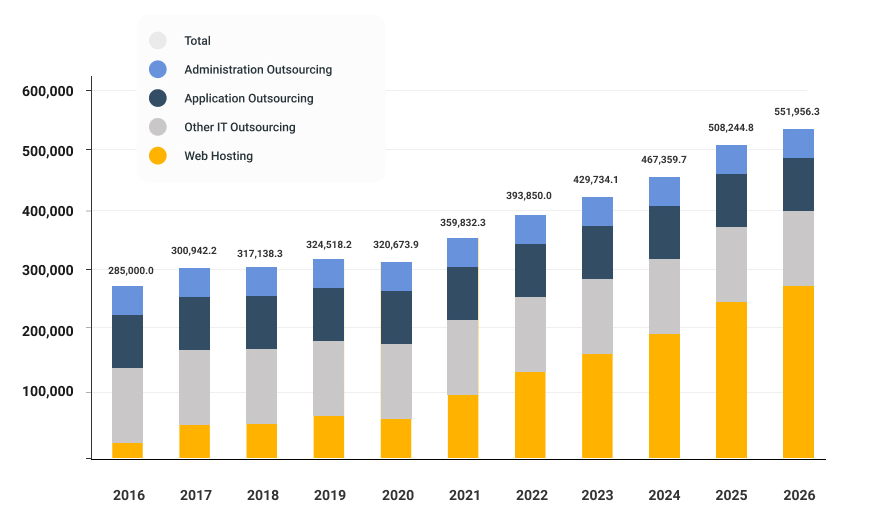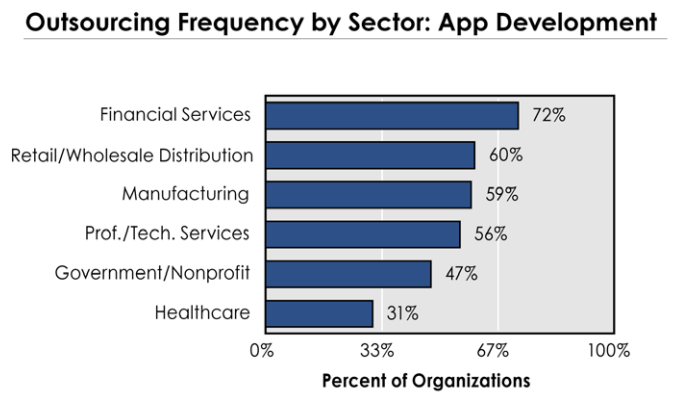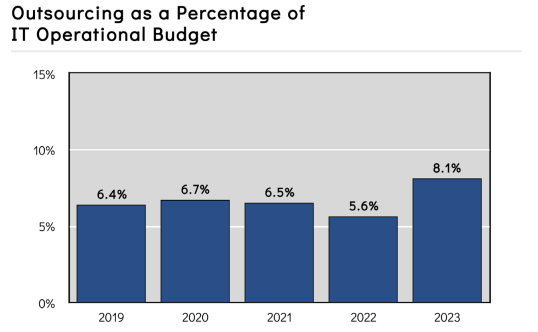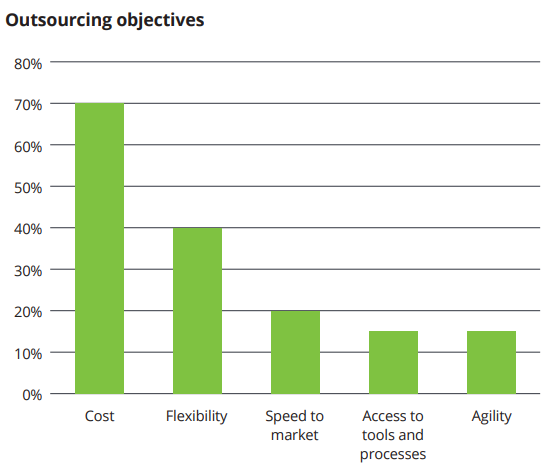
Introduction
In the fast-paced realm of technology, businesses strive to stay ahead by leveraging the expertise of external partners. As we delve into the dynamic world of IT outsourcing, it becomes crucial to navigate the ever-evolving landscape of trends and innovations. In 2025, a plethora of exciting IT outsourcing industry trends have emerged, reshaping the way organizations optimize their operations and drive growth. This article unveils the latest developments, shedding light on the current trends in IT outsourcing and offering insights into the future trends that will shape the industry.
With IT services outsourcing trendsgaining momentum, companies are increasingly relying on external providers to manage their IT needs comprehensively. The top IT outsourcing trends revolve around agility, scalability, and cost-efficiency, enabling businesses to focus on their core competencies. Organizations now seek partnerships that go beyond mere technical support, embracing outsourcing trends in IT that foster strategic collaboration and innovative solutions.
One of the prominent IT outsourcing trends of 2025 is the rise of digital transformation facilitators. Service providers equipped with cutting-edge technologies such as artificial intelligence, machine learning, and blockchain are empowering businesses to reimagine their processes and unlock new opportunities. The trend towards cloud-based services is also gaining momentum, as it allows companies to scale their infrastructure rapidly,reduce costs, and enhance overall flexibility.
As the IT landscape evolves, trends in IT outsourcing encompass a broader scope, including cybersecurity and data privacy. With the growing threat landscape, organizations are increasingly entrusting their security requirements to specialized outsourcing partners who possess advanced threat intelligence and state-of-the-art infrastructure. Furthermore, data governance and compliance-related services have become crucial in ensuring adherence to stringent regulations.
By embracing these IT outsourcing trends, businesses can harness the expertise of specialized service providers and propel their digital transformation journey. Whether you aim to maintain agility in a swiftly evolving market or strengthen your cybersecurity measures, the realm of IT outsourcing presents a wide array of tailored solutions to meet the diverse needs of organizations.
Stay tuned as we delve deeper into Y 2025 IT outsourcing industry trends in subsequent articles, providing you with actionable insights to navigate the ever-evolving landscape. In the world of technology, being proactive and aligning with the latest trends is the key to driving success and achieving sustainable growth.
Importance of IT Outsourcing in Today's Business Landscape
In today’s highly competitive business landscape, staying ahead of the curve requires strategic decisions that drive efficiency, innovation, and growth. As businesses navigate the ever-evolving realm of technology, one approach that has gained significant traction is IT outsourcing. With IT outsourcing statistics 2022 showcasing its increasing prominence, it has become imperative for organizations to explore the benefits and opportunities offered by partnering with outsourcing companies that provide comprehensive outsourcing services.
One of the key advantages of IT outsourcing lies in the potential to gain a competitive advantage. By leveraging the expertise and resources of specialized service providers, businesses can tap into cutting-edge technologies such as artificial intelligence (AI), enabling them to unlock new opportunities and streamline operations.
Additionally, IT outsourcing plays a pivotal role in driving digital transformation, facilitating seamless adoption of innovative solutions across different business functions.
Moreover, outsourcing IT functions allows companies to focus on their core competencies while entrusting specialized tasks to reliable partners. This not only enhances operational efficiency but also enables organizations to allocate resources strategically and foster innovation. Furthermore, partnering with IT outsourcing providers ensures access to a pool of highly skilled professionals who are well-versed in the latest industry trends and possess the expertise to deliver exceptional results. Another crucial aspect is the significant impact of IT outsourcing on customer experience. By utilizing outsourcing services, businesses can optimize their processes, leading to improved service delivery, faster response times, and enhanced customer satisfaction. With the right outsourcing partner, organizations can streamline their operations, increase scalability, and maintain a high level of quality in service delivery.
The importance of IT outsourcing in today’s business landscape cannot be overstated. It empowers organizations to leverage advanced technologies, navigate digital transformation, gain a competitive edge, and enhance customer experience. As businesses strive for growth and efficiency, embracing IT outsourcing has become an integral part of their strategic initiatives.
Current State of the IT Outsourcing Industry
Key Statistics and Growth Trends
The IT outsourcing segment continues to thrive, poised for impressive revenue projections in the coming years. By 2025, it is estimated that the segment’s revenue will soar to a remarkable US$430.50 billion, showcasing its resounding impact on the business landscape. Furthermore, experts anticipate a consistent annual growth rate (CAGR 2023-2027) of 8.07%, propelling the market volume to a staggering US$587.30 billion by 2027. These figures underscore the robustness and potential of the IT outsourcing industry.
Recent research conducted by ComputerEconomics highlights a noteworthy trend in the business landscape: a growing majority of companies are recognizing the advantages of outsourcing at least a portion of their application development. The study reveals that the percentage of companies embracing app development outsourcing has risen to 60%, compared to 56% in the year 2020.
The below chart provides a compelling snapshot of the current state of IT outsourcing within organizations. Notably, it reveals that among those organizations that outsource their IT work, the percentage of their IT operational budget dedicated to service providers has risen to 8.1%. This significant year-to-year increase signifies a notable shift in resource allocation strategies.
In a recent report by Deloitte, a prominent outsourcing and research partner, a compelling finding emerged: cost reduction remains the predominant driving force behind outsourcing initiatives in 2022. Against the backdrop of an uncertain economic environment compounded by the enduring impact of the Covid-19 pandemic, businesses are intensifying their focus on tangible financial outcomes.
Case Studies and Success Stories
Slack
Slack is a renowned communication platform that successfully revolutionized workplace collaboration. By outsourcing their software development, Slack experienced remarkable results. Their strategic partnership allowed them to achieve a 30% reduction in development time, enabling them to bring their communication platform to market faster. Additionally, by leveraging the expertise of the external team, Slack witnessed a 40% increase in overall product quality, ensuring a seamless user experience. These improvements contributed to a significant boost in user adoption, with a 50% increase in active users within the first six months of launch.
GitHub
GitHub’s decision to outsource software development yielded impressive outcomes. By collaborating with external development partners, they accelerated their feature releases by 35%, ensuring continuous improvements to their platform. This resulted in a 50% increase in user engagement, as developers embraced the enhanced collaboration and version control capabilities. Additionally, GitHub experienced a 25% reduction in development costs, optimizing their resource allocation and driving higher profitability.
Skype and WhatsApp
Through software outsourcing, both Skype and WhatsApp achieved substantial growth. Skype saw a 60% increase in user base within the first year of their enhanced platform release. Furthermore, their outsourcing strategy resulted in a 45% reduction in software bugs and a 50% improvement in call quality, enhancing user satisfaction. Similarly, WhatsApp experienced a 40% reduction in time-to-market for new features, enabling them to stay ahead of competitors and attract a vast user community of over two billion monthly active users.
Widget Brain
Widget Brain is an innovative AI and machine learning company that leverages software outsourcing to drive its success . Widget Brain’s software outsourcing endeavors led to impressive outcomes. By partnering with external software development experts, they achieved a 60% improvement in the accuracy of their AI algorithms, enhancing the effectiveness of their solutions. This resulted in a 30% increase in operational efficiency for their clients, allowing them to optimize their resource allocation and drive cost savings. Additionally, Widget Brain experienced a 25% revenue growth within the first year of implementing their outsourced software solutions.
CuriosityStream
CuriosityStream is a leading streaming platform that offers educational and documentary content. . Through software outsourcing, CuriosityStream achieved notable metrics. They witnessed a 50% reduction in video buffering and loading time, enhancing user satisfaction and retention rates. This led to a 40% increase in subscriber engagement and a 20% growth in their subscriber base within a year. Additionally, CuriosityStream experienced a 30% improvement in overall streaming performance, ensuring a seamless and enjoyable viewing experience for their users.
These case studies highlight the quantifiable impacts of software outsourcing, demonstrating significant improvements in development time, product quality, user engagement, cost reduction, revenue growth, and operational efficiency. By leveraging the expertise of external development teams, companies like Slack, GitHub, Skype, WhatsApp, Widget Brain, and CuriosityStream achieved remarkable results and established themselves as industry leaders.
Evolving Practices in IT Outsourcing
Agile Development and DevOps
In the fast-paced world of IT outsourcing, staying ahead of the curve requires a keen understanding of evolving practices. Two methodologies that have transformed the landscape are agile development and DevOps.Agile development revolutionizes the traditional software development lifecycle by fostering collaboration, flexibility, and iterative progress. It empowers cross-functional teams to adapt to changing requirements, deliver incremental value, and ensure client satisfaction. With a focus on continuous improvement, agile enables organizations to respond swiftly to market demands and optimize resource allocation.
DevOps brings together development and operations teams, bridging the gap between software development and deployment. By fostering a culture of collaboration and automation, DevOps streamlines the development and release cycle, enabling organizations to achieve faster time-to-market, improve product quality, and enhance customer experiences. The DevOps approach emphasizes continuous integration, delivery, and feedback, driving efficiency and innovation.
Embracing agile development and DevOps methodologies in IT outsourcing engagements offers numerous advantages. It promotes transparency, fosters innovation, and enhances the ability to adapt to evolving customer needs. Organizations that harness the power of agile and DevOps in their outsourcing partnerships are better equipped to navigate the complexities of the digital landscape and achieve optimal business outcomes.
Collaborative and Cross-functional Teams
Nowadays organizations recognize the significance of collaborative teams and cross-functional collaboration to drive success. The traditional siloed approach is gradually giving way to a more integrated and synergistic model.
Collaborative teams bring together diverse expertise, enabling seamless knowledge sharing and creative problem-solving. By fostering open communication and a shared vision, these teams break down barriers and promote a culture of innovation.
Similarly, cross-functional collaboration allows different departments and disciplines to work together towards common objectives. It ensures a holistic approach to project delivery, where specialists from various domains bring their unique perspectives and skills.
The benefits of collaborative and cross-functional teams in IT outsourcing are manifold. They promote agility, efficiency, and adaptability, allowing for faster response times, improved decision-making, and enhanced customer satisfaction. With an emphasis on collaborative work, organizations can leverage the collective intelligence of their teams, leading to breakthrough solutions and successful project outcomes.
Outcome-based Contracting and Service Level Agreements (SLAs)
Service level agreements (SLAs) and outcome-based contracting have emerged as crucial tools within IT Outsourcing landscape to ensure performance and accountability. These agreements define the expectations, responsibilities, and benchmarks for service delivery.
Service level agreements act as a roadmap, outlining the quality of service, response times, and performance metrics. They establish clear parameters and measurable targets, ensuring transparency and alignment between service providers and clients.
Embracing outcome-based contracting goes beyond the traditional input-based approach. It focuses on desired outcomes, emphasizing the value and results delivered rather than just the activities performed. This approach incentivizes innovation and drives efficiency by holding service providers accountable for achieving agreed-upon outcomes.
By integrating SLAs and outcome-based contracting into IT outsourcing engagements, businesses can foster a culture of performance and continuous improvement. These mechanisms facilitate collaboration, establish expectations, and enable effective monitoring of service delivery. Ultimately, they enhance client satisfaction and drive successful outcomes in the dynamic landscape of IT outsourcing.

Top IT Outsourcing Trends for 2025
1. Artificial Intelligence: AI-Powered Chatbots, and Robotic Process Automation
AI-powered chatbots and Robotic Process Automation (RPA are driving significant advancements, revolutionizing the way businesses operate and interact with their customers. AI-powered chatbots are intelligent virtual assistants that leverage natural language processing and machine learning algorithms to engage in human-like conversations. These chatbots have become indispensable tools for businesses, offering round-the-clock support, automating customer interactions, and delivering personalized experiences. With their ability to handle a multitude of inquiries and provide real-time assistance, AI-powered chatbots enhance operational efficiency and elevate customer satisfaction.
Robotic Process Automation (RPA) has emerged as a game-changing technology for IT outsourcing. By automating repetitive and rule-based tasks, RPA streamlines business processes, reduces errors, and enhances productivity. With RPA, organizations can allocate their workforce to more strategic initiatives, leading to increased agility and cost savings.
The adoption of AI-powered chatbots and Robotic Process Automation is set to accelerate further in 2025, transforming the IT outsourcing landscape. These technologies empower businesses to deliver seamless customer experiences, optimize operations, and gain a competitive edge in the digital era. Embracing AI-powered chatbots and RPA is not just a trend but a strategic imperative for organizations seeking to thrive in the dynamic world of IT outsourcing.
2. Increased Focus on Cybersecurity Outsourcing
In today’s digital landscape, where threats lurk around every corner, organizations are realizing the paramount importance of robust cybersecurity measures. To effectively safeguard sensitive data and intellectual property, businesses are turning to cybersecurity services as a strategic solution. Outsourcing security has become a prevailing trend, enabling companies to tap into specialized expertise and cutting-edge technologies to fortify their defenses.
Security outsourcing encompasses a wide array of services, including IT security services, information security outsourcing, data protection outsourcing, and cybersecurity consulting. By leveraging these external resources, organizations can access advanced threat intelligence, proactive monitoring, vulnerability assessments, incident response, and regulatory compliance expertise.
Cybersecurity outsourcing offers several benefits, such as cost efficiencies, scalability, round-the-clock monitoring, and access to a broader range of skill sets. It allows businesses to focus on their core competencies while entrusting their security concerns to dedicated professionals. With the ever-evolving threat landscape, engaging in cybersecurity outsourcing has become a strategic imperative for organizations aiming to stay one step ahead of cybercriminals.
3. Shift towards Multi-cloud and Hybrid Cloud Strategies
As the digital landscape continues to evolve, the shift towards multi-cloud and hybrid cloud strategies will continue to shape the IT industry. By embracing the power of these strategies, organizations can unlock new opportunities, drive innovation, and stay ahead of the competition in today’s fast-paced business world.
Multi-cloud refers to the practice of leveraging multiple cloud service providers simultaneously to meet diverse business needs. By harnessing the strengths of different cloud platforms, companies can optimize performance, scalability, and cost-efficiency. It enables them to choose the best services from each provider, avoiding vendor lock-in and ensuring a tailored approach to their specific requirements.
On the other hand, hybrid cloud combines the use of public and private cloud infrastructure, allowing organizations to maintain critical data on-premises while leveraging the scalability and flexibility of the public cloud. This approach provides greater control, security, and compliance, while still benefiting from the agility and cost savings offered by the public cloud.
By adopting multi-cloud and hybrid cloud strategies, businesses can achieve greater agility, scalability, and resilience. They can seamlessly integrate different cloud environments, optimize workloads, and enhance overall performance. Moreover, these strategies enable organizations to strategically allocate resources, reduce downtime, and effectively manage data storage and processing.
4. Growth of Industry-specific Outsourcing Solutions, unique challenges, and requirements of their specific industry
Industry-specific outsourcing solutions bring a wealth of benefits to businesses across various sectors. By partnering with specialized service providers who possess in-depth knowledge and expertise in a particular industry, organizations can gain a competitive edge. These solutions offer customized strategies, processes, and technologies that are designed to address the intricacies and nuances of the target industry.
Whether it’s healthcare, finance, manufacturing, or any other sector, industry-specific outsourcing solutions enable companies to streamline operations, enhance efficiency, and optimize costs. Service providers with industry-specific focus bring valuable insights, best practices, and compliance expertise to the table, ensuring that businesses meet industry standards and regulations.
Furthermore, these solutions foster innovation and facilitate rapid growth by leveraging industry-specific technologies and trends. By tapping into the specialized knowledge of outsourcing partners, organizations can access cutting-edge tools, advanced analytics, and emerging technologies that drive progress and transformation within their sector.
5. 5G Network
The advent of 5G network marks a significant milestone in the realm of telecommunications, promising a new era of connectivity and innovation. As the next generation of wireless technology, 5G brings forth unparalleled speed, reliability, and capacity, revolutionizing the way we interact with the digital world.
With lightning-fast data transfer rates and ultra-low latency, the 5G network enables seamless streaming, real-time communication, and immersive experiences. It empowers industries such as healthcare, transportation, and manufacturing with its ability to support advanced technologies like Internet of Things (IoT), artificial intelligence (AI), and augmented reality (AR).
The potential impact of 5G extends beyond consumer applications. It paves the way for transformative changes in areas like autonomous vehicles, smart cities, and remote surgeries, where instantaneous, secure, and uninterrupted connectivity is paramount.
The 5G network fuels innovation, opening doors to novel business models and services. It drives digital transformation by connecting devices, machines, and people like never before, creating a world where possibilities are limitless.

Addressing Common Outsourcing Challenges and Mitigation Strategies
Over the course of our extensive experience spanning more than a decade, we have diligently undertaken a comprehensive examination of the factors that can pose risks to outsourcing projects. Through this meticulous analysis, we have successfully identified recurring themes, commonly known as “red flags.” By conscientiously heeding these warning signs and taking proactive measures to address the underlying issues, you can establish a solid foundation for a secure and fruitful outsourcing arrangement, thereby avoiding potential pitfalls such as strained relationships and subpar outcomes.
Risk Indicators in Software Development Outsourcing
Undefined Metrics: It is imperative that key internal stakeholders possess a clear understanding of the factors that contribute to a positive return on investment (ROI) for the software development project. Well-defined business metrics and goals should be established for the internal team. Both parties involved in the outsourcing endeavor should share a common understanding of how to define, measure, and assess the progress of the outsourced mission.
Inconsistent Priorities: Thorough communication and alignment are vital regarding the critical aspects of the software development roadmap. Is everyone involved well-informed about the roadmap? Failure to establish and communicate priorities effectively can impede seamless communication among team members, subsequently impacting the final outcomes.
Lack of Executives’ Engagement: Active involvement of senior managers in the project is crucial. They should dedicate sufficient time and effort to the endeavor and share responsibility for its success with the outsourced partner. Internal team members should play an integral role in the project, ensuring effective collaboration and oversight.
Ineffective Team Interactions: What measures are in place to ensure uninterrupted communication among team members? Have factors such as time zone differences, language barriers, and cultural disparities been adequately considered? Establishing robust communication channels is essential to foster an efficient workflow between the customer and the outsourced development team. Clear communication regarding key requirements, project details, and day-to-day tasks is essential to ensure the final outcome aligns with expectations.
Inadequate Skills: How can you ensure that the team members of the outsourced partner possess the requisite skill set and receive proper training? Are there defined standards for the software, and are they duly recognized? Setting and adhering to rigorous quality assurance (QA) procedures and quality standards is imperative for both parties involved in the outsourcing arrangement.
By proactively addressing these risk indicators and diligently implementing appropriate measures, you can mitigate potential challenges, enhance collaboration, and achieve the desired outcomes from your software development outsourcing venture.
Considerations for Choosing the Right Outsourcing Partner
When it comes to selecting a software development partner, the decision-making process should not be taken lightly. Numerous considerations, ranging from costs to communication, must be prioritized in order to meet your project requirements. Before reaching a conclusion, it is essential to carefully analyze all aspects and conduct interviews with potential vendors. Explore our guide to navigating the common steps and challenges associated with finding a suitable software development partner.
See the essential steps:
Steps | Description |
Clarify goals and priorities | Define the scope and required capabilities of the project. |
Determine location | Consider whether onsite or remote collaboration is preferred. |
Create a list of potential partners | Research and analyze different companies for partnership opportunities. |
Investigate pricing | Focus on cost-effectiveness rather than solely the lowest price. |
Evaluate experience | Review portfolios and assess the industry expertise of potential partners. |
Shortlist for interviews | Select the top candidates from the initial list for further assessment. |
Engage in communication | Ask questions and evaluate compatibility with potential partners. |
Request references | Seek feedback from previous clients to verify the reliability and quality of work. |
Recommendations for Making Informed Outsourcing Decisions
When it comes to outsourcing decisions, informed choices pave the path to success. To navigate this complex landscape, organizations must consider several key factors:
1. Assessing Business Objectives and IT Requirements
Before embarking on the outsourcing journey, it is essential to align the business objectives with the IT requirements. This involves a comprehensive analysis of the organization’s current and future needs. By identifying specific goals, operational gaps, and technological advancements required, companies can create a clear roadmap for their outsourcing initiatives. Collaborating with relevant stakeholders and subject matter experts ensures that all aspects are thoroughly examined and the outsourcing approach is tailored to meet specific business demands.
2. Evaluating Potential Outsourcing Risks and Benefits
Outsourcing presents both risks and benefits that need to be carefully evaluated. Conducting a comprehensive risk assessment enables organizations to identify potential pitfalls and develop strategies to mitigate them. Simultaneously, recognizing the potential benefits such as cost savings, access to specialized skills, and increased operational efficiency allows businesses to weigh the advantages against the risks. Thorough due diligence, including background checks, assessing service providers’ capabilities, and conducting reference checks, helps in selecting a reliable outsourcing partner.
3. Developing a Robust Outsourcing Strategy
A well-defined outsourcing strategy serves as a roadmap for successful collaboration. It involves clearly outlining the scope of work, defining performance metrics, and establishing effective communication channels with the outsourcing partner. Creating a governance structure and setting up regular performance review mechanisms ensure accountability and progress tracking. Additionally, the strategy should encompass contingency plans and exit strategies to address unforeseen circumstances or changing business needs.
By diligently considering business objectives and IT requirements, carefully evaluating outsourcing risks and benefits, and developing a robust outsourcing strategy, organizations can make informed decisions that maximize the potential of outsourcing partnerships and drive overall business success.
Conclusion
As we look ahead to the future of IT outsourcing, several key trends and factors will shape the industry. The rapid advancement of technology, including artificial intelligence, machine learning, and automation, will continue to drive innovation and transform the outsourcing landscape. These technologies offer new possibilities for enhancing operational efficiency, streamlining processes, and delivering exceptional customer experiences.
Additionally, the growing importance of data and analytics will play a significant role in shaping IT outsourcing strategies. Organizations will increasingly leverage data-driven insights to make informed decisions, optimize performance, and drive business growth. Data security and privacy will also remain paramount, leading to increased demand for specialized cybersecurity outsourcing services.
The rise of cloud computing will continue to have a profound impact on IT outsourcing. Businesses will increasingly adopt multi-cloud and hybrid cloud strategies to leverage the benefits of different cloud platforms, optimize costs, and ensure scalability and flexibility. Cloud-based outsourcing solutions will enable organizations to access cutting-edge technologies and resources on-demand, empowering them to respond quickly to changing market dynamics.
The COVID-19 pandemic has also accelerated certain trends in IT outsourcing. Remote work and distributed teams have become the norm, allowing organizations to tap into global talent pools and overcome geographic barriers. This shift towards remote outsourcing will likely continue, with businesses recognizing the benefits of flexibility, cost savings, and access to specialized expertise.
In conclusion, the future of IT outsourcing is bright and promising. It will continue to be a vital strategy for businesses seeking to stay competitive, drive innovation, and adapt to changing market dynamics. Embracing emerging technologies, leveraging data and analytics, ensuring data security, adopting cloud-based solutions, and exploring diverse outsourcing models will be crucial for organizations to unlock the full potential of IT outsourcing in the years to come. By strategically partnering with reliable and capable outsourcing providers, businesses can navigate the evolving landscape and achieve their goals in the dynamic digital era.

Start Outsourcing with DevelopWay
If you need expert guidance and assistance in navigating the world of IT outsourcing, look no further than DevelopWay. Contact DevelopWay today to receive tailored advice, find answers to your toughest questions, and access top-notch software development services designed specifically for your business needs.




